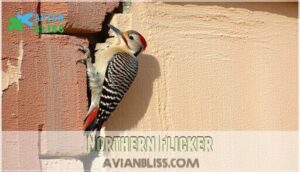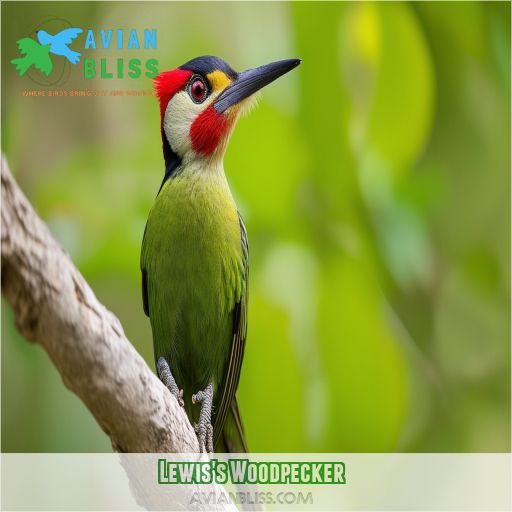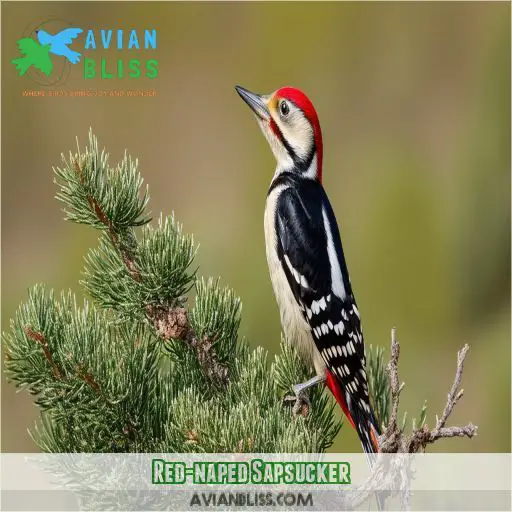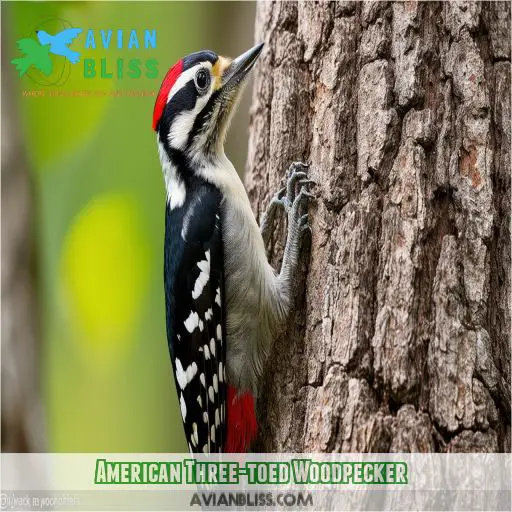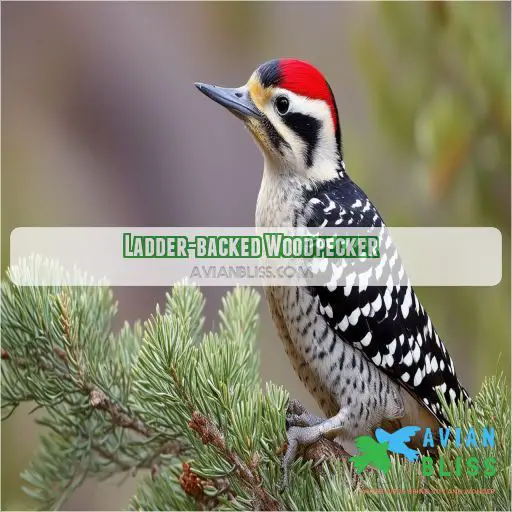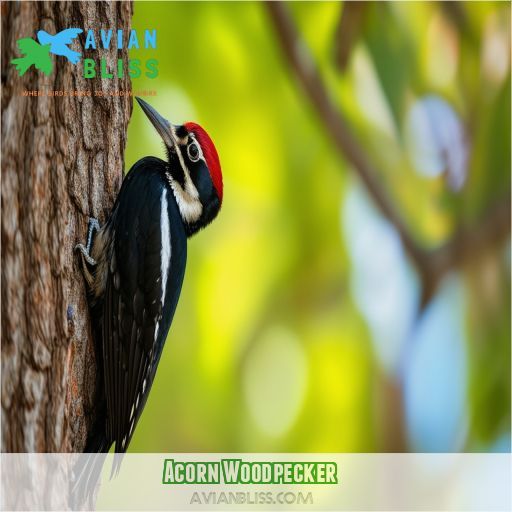This site is supported by our readers. We may earn a commission, at no cost to you, if you purchase through links.
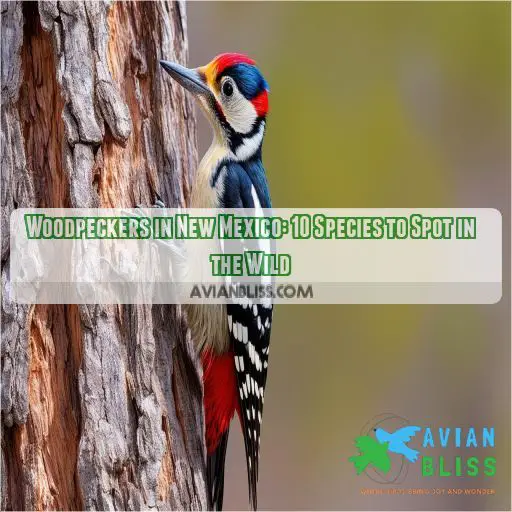 Discover the diverse world of woodpeckers in New Mexico with this guide to 10 fascinating species you can spot in the wild.
Discover the diverse world of woodpeckers in New Mexico with this guide to 10 fascinating species you can spot in the wild.
From the familiar Downy Woodpecker to the unique Lewis’s Woodpecker, you’ll learn how to identify these remarkable birds by their appearance, behavior, and habitat preferences.
Whether you’re an avid birder or a casual nature enthusiast, exploring New Mexico’s woodpecker population offers a chance to observe these skilled tree-dwelling creatures in their natural environment.
Get ready to enhance your birdwatching skills and expand your knowledge of local wildlife.
Table Of Contents
- Key Takeaways
- Downy Woodpecker
- Hairy Woodpecker
- Northern Flicker
- Red-headed Woodpecker
- Lewis’s Woodpecker
- Red-naped Sapsucker
- Williamson’s Sapsucker
- American Three-toed Woodpecker
- Ladder-backed Woodpecker
- Acorn Woodpecker
- Frequently Asked Questions (FAQs)
- Are woodpeckers protected in New Mexico?
- Are woodpeckers good to have in your yard?
- What scares woodpeckers away from your house?
- What is the difference between a red headed woodpecker and a pileated woodpecker?
- How do woodpeckers avoid brain damage while pecking?
- What role do woodpeckers play in New Mexicos ecosystems?
- Can woodpeckers damage houses in New Mexico?
- How do New Mexicos climate changes affect woodpecker populations?
- Are there any woodpecker-watching hotspots in New Mexico?
- Conclusion
Key Takeaways
- New Mexico is a woodpecker wonderland! With 10 fascinating species to spot, from the pint-sized Downy to the striking Lewis’s Woodpecker, you’ll be playing a real-life game of "Where’s Woody?" in no time.
- These feathered jackhammers are more than just noisy neighbors. They’re nature’s pest control, forest doctors, and apartment builders all rolled into one. Talk about overachievers!
- Woodpeckers are the ultimate survivalists, equipped with built-in shock absorbers and third eyelids. They’re basically the Chuck Norris of the bird world, minus the roundhouse kicks.
- Climate change is giving woodpeckers a run for their money, forcing them to play musical trees as their habitats shift. But these adaptable birds aren’t throwing in the towel just yet – they’re rewriting their own flight plans.
Downy Woodpecker
You can easily identify the Downy Woodpecker by its small size and distinctive black and white plumage, often seen darting energetically through backyards in New Mexico. This species thrives in a variety of habitats, from suburban areas to wooded environments, making it a frequent and fascinating visitor across the state.
Characteristics and Behavior
The Downy Woodpecker is the smallest of its kind. Black and white plumage, with a tiny bill.
Exceptionally social, these birds spend their afternoons perched and calling.
Known for their high-pitched whinnying and fast drumming.
You can spot them in backyards across New Mexico, where they favor milder climates and typically build their nests high up.
Habitat and Distribution
The Downy Woodpecker, the smallest of its kind, is a common sight in backyards across New Mexico, with a preference for native trees. You’ll often spot them in forest land, where they’re known to make their nests high up. Their distribution and density are linked to microhabitat use, ecological interactions, and range expansions.
Hairy Woodpecker
The Hairy Woodpecker, larger and with a longer bill than the Downy Woodpecker, has distinct black and white plumage and prefers coniferous trees. You won’t often find this species in backyards, as it tends to inhabit mature forests, emphasizing its adaptability to different environments across New Mexico.
Physical Traits and Distinctions
Hairy woodpeckers are larger than their downy cousins, with longer bills. Here are some key physical traits to help you distinguish them from other species:
- Black and white plumage: Their backs and wings are primarily black and white, with some brown tinges on their fronts.
- Red crown: A distinctive feature is the red crown sweeping back from the base of their beaks.
- Facial markings: They’ve prominent black markings around their faces and beaks.
- Distinctive calls: Hairy woodpeckers have a short, sharp "peek" call, as well as a rattling or whinnying sound.
Habitat Preferences
Hairy woodpeckers are most at home in coniferous forests, where they can often be spotted foraging for food or nesting high up in the trees. These birds are less commonly seen in backyards, preferring the seclusion of denser woodland areas.
Northern Flicker
The Northern Flicker is easily recognized by its loud, ringing "wicka-wicka-wicka" call. This large woodpecker comes in two distinct color variations – the yellow-shafted and red-shafted forms – which differ in their geographic distributions across North America.
Identifying Features
The Northern Flicker is easily identified by its loud, ringing "wicka-wicka-wicka" call and colorful plumage. These medium-sized woodpeckers have brown-spotted plumage, with a white rump that’s visible in flight. Males sport a distinctive red mustache, while females display a black one.
- Medium-sized with brown-spotted plumage
- White rump visible in flight
- Males have a red mustache, while females have a black one
- Loud, ringing call
Geographic Variations
Northern Flickers are known for their geographic variations, with several subspecies spread across North America. These variations can be seen in their plumage patterns and colors, with some having more red on their heads or different patterns on their backs. For example, the ladder-backed Northern Flicker has a distinctive pattern on its back, resembling a ladder, as its name suggests.
These woodpeckers are versatile in their nesting preferences, choosing spots in cacti or even your backyard bird bath. They’re social birds, often nesting near other woodpeckers, like the Red-naped Sapsucker or Lewis’s Woodpecker.
Red-headed Woodpecker
When spotting the Red-headed Woodpecker, you’ll notice its striking red head, white body, and black wings, and its shrill "tchur" call as it darts through the trees. This species prefers open woodlands, where it forages for insects and nests in dead tree cavities.
Appearance and Calls
The Red-headed Woodpecker is easily identified by its bright red head, neck, and throat, with a contrasting white body and black wings and tail. Its call is a shrill "tchur" sound.
These woodpeckers are social birds, often nesting in close proximity to others of their kind. They prefer milder climates and are typically found in forest habitats, where they build their nests high up in trees.
Habitat and Behavior
Red-headed woodpeckers are extremely sociable with their fellow woodpeckers and are known for their penchant for pecking and nesting at great heights. Here are some key aspects of their habitat and behavior:
- They can be found in a variety of habitats, including forest spots and arid conditions.
- These woodpeckers aren’t limited to the US and can also be spotted in Central America.
- While they don’t shy away from extreme heights, they do have a preference for milder climates.
Lewis’s Woodpecker
Lewis’s Woodpecker stands out with its striking black head, pink belly, and green collar, making it easy to identify. It breeds in northern New Mexico and winters in the Pecos Valley, though it rarely visits backyards.
Unique Traits and Behaviors
Lewis’s Woodpeckers are easily distinguished by their black heads and wings, pink bellies, and green collars. They make a harsh "churr" call, which is more noticeable in males.
This species is a winter visitor to New Mexico, breeding in the northern part of the state and wintering in the Pecos Valley. They rarely visit backyards, so spotting them requires venturing into their habitat.
Conservation efforts are imperative for Lewis’s Woodpeckers as they face threats from habitat destruction and climate change. Protecting their environment and understanding their unique behaviors through citizen science initiatives are paramount steps to guarantee their survival.
Seasonal Movement Patterns
Lewis’s Woodpeckers are seasonal visitors to New Mexico.
They breed in the northern regions and winter in the Pecos Valley.
These birds are not often seen in backyards, so you’ll have to explore to spot them.
Lewis’s Woodpeckers are distinguished by their black heads, pink bellies, and green collars, favouring milder climates.
While their population is stable, they are still considered rare in the US, with a small overall population.
Red-naped Sapsucker
The red-naped sapsucker is a striking woodpecker with a distinctive red nape and throat. This species favors mixed coniferous and deciduous forests across the southwestern United States, including parts of New Mexico.
Physical Appearance and Markings
You’ll be able to spot the Red-naped Sapsucker by its distinctive black and white plumage, with red crowns sweeping back and black markings around its face and beak. It also has brown tinges on its front. Although small, this woodpecker is unabashedly noisy.
Habitat and Range
The red-naped sapsucker, a woodpecker species, is native to arid regions across the southern and southwestern United States, as well as Central America.
These birds typically nest in cacti or forested areas.
While they do not exhibit a preference for any particular tree species when it comes to foraging, they also feed on the ground and in shrubs.
Some individuals migrate during the winter, however, the impact of climate change on this behavior remains uncertain.
Williamson’s Sapsucker
The Williamson’s Sapsucker displays striking sexual dimorphism, with males boasting black plumage and yellow bellies, while females have brown heads and striped upperparts. They feed by drilling holes in trees to extract sap and insects, making them fascinating to observe in their natural habitat.
Plumage and Sexual Dimorphism
With its striking plumage, the Williamson’s Sapsucker presents an exemplary case of sexual dimorphism within birds.
Males are characterized by a sleek black coat, complemented by a vibrant yellow belly.
Females, on the other hand, display a more subdued palette, featuring a brown head and striped upperparts.
This distinct coloration plays a pivotal role in their mating behaviors, aiding in their quest to attract potential partners.
Young birds also have their own unique juvenile coloration, and as they journey through maturity, molting patterns orchestrate a gradual transformation, revealing the striking adult plumage that captivates bird enthusiasts today.
Feeding Behavior and Tree Drilling
As a year-round resident of central New Mexico, the Williamson’s Sapsucker is an expert at extracting tree sap and insects from drilled holes in bark. Here are some interesting facts about their feeding behavior and tree drilling:
- They create woodpecker holes in trees to access the sap and insects within.
- Drilling into bark is a specialized skill they use to obtain food.
- Nest building is another reason for their drilling, creating safe spaces high up in trees.
- These birds are skilled insect hunters, using their beaks to extract bugs from trees.
- The sap provides a valuable energy source, especially in colder months.
American Three-toed Woodpecker
The American Three-toed Woodpecker is well-adapted to coniferous habitats, making it a specialist in New Mexico’s forested areas. You’ll often spot it in higher-altitude regions, where it forages on dead or dying trees.
Adaptations for Coniferous Habitats
Unlike its cousins, the American Three-toed Woodpecker has some clever adaptations for life in coniferous habitats.
You’ll notice its unique foraging techniques, like flaking bark instead of drilling. This method is perfect for catching bark beetles in spruce and pine forests.
Its winter feeding strategies are impressive too, as it’s able to find food when other woodpeckers might struggle.
The American Three-toed Woodpecker truly excels at making the most of its habitat.
Range and Known Locations in New Mexico
You’ll find the American Three-toed Woodpecker in New Mexico’s high-elevation coniferous forests. They’re most common in the Sangre de Cristo Mountains and the San Juan Mountains.
These birds don’t migrate, but they may move to lower elevations in winter.
While their population is stable, they’re sensitive to habitat loss.
Keep an eye out for their distinctive black-and-white plumage and yellow crown when exploring these areas.
Ladder-backed Woodpecker
You’ll recognize the Ladder-backed Woodpecker by its distinctive black and white barred back, resembling a ladder, and its sharp "peek" call. These woodpeckers prefer to nest in cacti or dead trees in arid regions of New Mexico, often excavating their cavities at heights of 5 to 15 feet above the ground.
Distinctive Features and Vocalizations
You’ll recognize the Ladder-backed Woodpecker by its distinctive black-and-white barred back, resembling a ladder.
Its foraging habits include probing bark crevices for insects. Listen for its sharp "peek" call or rapid drumming on trees.
This woodpecker’s physical adaptations, like a strong bill and stiff tail feathers, make it a master at climbing and pecking.
Their vocal communication includes a variety of chirps and rattles.
Preferred Nesting Sites
Now that you’ve learned to identify the Ladder-backed Woodpecker’s distinctive features, let’s explore where they establish their nests. These birds are selective in their choice of nesting locations. You’ll find them excavating cavities in:
- Dead or dying trees
- Cacti, particularly saguaros
- Wooden poles or fence posts
Their nesting height preferences vary from 5 to 40 feet above ground. They’re adaptable, choosing sites that provide protection and convenient access to food sources.
Acorn Woodpecker
You’ll find Acorn Woodpeckers year-round in New Mexico, easily recognized by their unique food storage habits. These resourceful birds drill holes in trees or utility poles to create "granaries," where they stash acorns for later consumption, ensuring a steady food supply throughout the seasons.
Foraging Habits and Food Storage
Unlike the Ladder-backed Woodpecker, you’ll find Acorn Woodpeckers living up to their name. They’re nature’s pantry preppers, storing thousands of acorns in specially drilled holes. Their foraging habits and food storage techniques are truly remarkable:
| Behavior | Description |
|---|---|
| Granary Trees | Create "granaries" in dead trees |
| Acorn Hoarding | Store up to 50,000 acorns per tree |
| Group Effort | Families work together to gather food |
| Insect Catching | Snag flying insects mid-air like flycatchers |
These social birds have mastered the art of food preservation, ensuring they’re well-fed year-round.
Year-round Presence in New Mexico
You’ll find Acorn Woodpeckers in New Mexico year-round, providing ample opportunities for observation. Their population trends remain stable, thanks to conservation efforts. Here’s what you need to know about their year-round presence:
- Nesting preferences: Favors oak woodlands
- Climate change impacts: Shifting ranges northward
- Habitat conservation: Critical for long-term survival
- Population monitoring: Ongoing citizen science projects
Keep an eye out for these charismatic birds as you explore New Mexico’s diverse landscapes.
Frequently Asked Questions (FAQs)
Are woodpeckers protected in New Mexico?
With 13 million woodpeckers across the continent, you’re likely to spot one in New Mexico. They’re protected under the Migratory Bird Treaty Act, making it illegal to harm, capture, or kill these feathered friends without a permit.
Are woodpeckers good to have in your yard?
Yes, woodpeckers are beneficial for your yard. They’ll control insect populations, especially wood-boring pests. You’ll enjoy their natural pest control services and charming antics. Plus, they create nesting cavities that benefit other bird species.
What scares woodpeckers away from your house?
Like a phantom haunting your home, woodpeckers can be persistent. You’ll scare them away with reflective objects, predator decoys, and loud noises. Seal holes, use deterrent tape, and install physical barriers to protect your house from their drilling.
What is the difference between a red headed woodpecker and a pileated woodpecker?
You’ll notice red-headed woodpeckers have entirely crimson heads, while pileated woodpeckers sport a red crest. Size-wise, pileated woodpeckers are much larger. Their calls differ too – red-headed’s make a sharp "tchur," while pileated’s produce a loud, resonant "cuk-cuk-cuk.
How do woodpeckers avoid brain damage while pecking?
You’ll be amazed by woodpeckers’ built-in shock absorbers! Their skull’s spongy bone, strong neck muscles, and specialized tongue placement cushion the brain. They’ve also got a third eyelid that keeps their eyeballs from popping out during intense pecking sessions.
What role do woodpeckers play in New Mexicos ecosystems?
You’ll find woodpeckers playing essential roles in New Mexico’s ecosystems. They’re nature’s pest controllers, keeping insect populations in check. They’re also ecosystem engineers, creating nesting cavities that benefit other species. Their foraging helps maintain forest health.
Can woodpeckers damage houses in New Mexico?
Like a determined Terminator, woodpeckers can inflict damage on your house. They’ll drill holes, peck at siding, and create noise. You’re not helpless, though. Install deterrents or seek professional help to protect your home from these persistent birds.
How do New Mexicos climate changes affect woodpecker populations?
Climate changes in New Mexico affect woodpecker populations through shifting food sources and habitat availability. You’ll notice altered migration patterns, breeding seasons, and population densities as these adaptable birds respond to temperature and precipitation fluctuations in their environments.
Are there any woodpecker-watching hotspots in New Mexico?
You’ll find excellent woodpecker-watching spots in New Mexico’s diverse habitats. Head to the Gila National Forest, Bandelier National Monument, or Bosque del Apache National Wildlife Refuge. These areas offer prime opportunities to observe various species in their natural environments.
Conclusion
Like a feathered treasure hunt, discovering woodpeckers in New Mexico offers a thrilling adventure for bird enthusiasts. You’ve now got an extensive guide to 10 diverse species, from the common Downy to the unique Lewis’s Woodpecker.
Armed with knowledge of their distinct features, habits, and habitats, you’re well-equipped to spot these remarkable birds in the wild. Remember, patience and keen observation are key.



